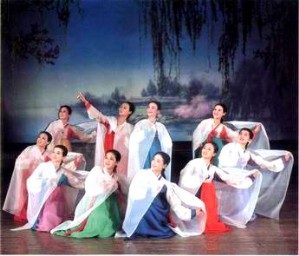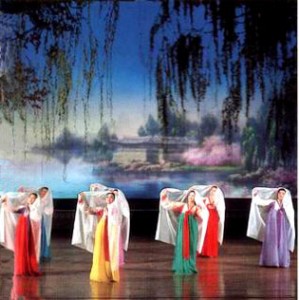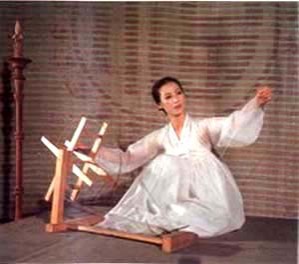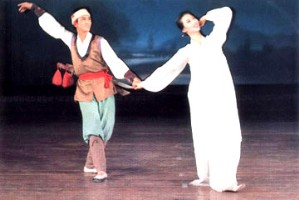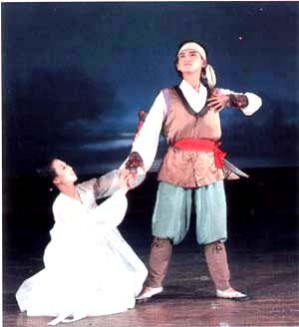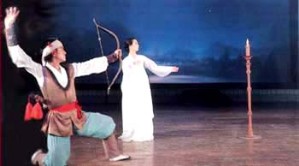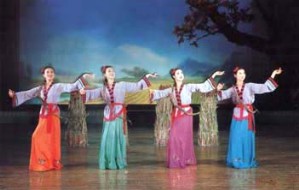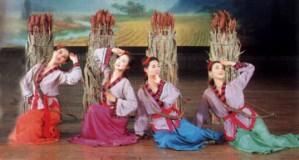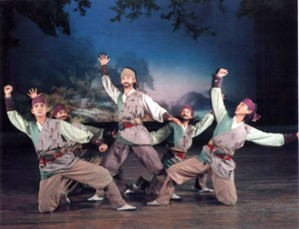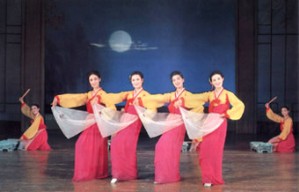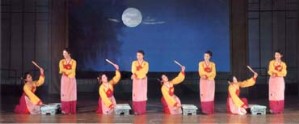The folk dance suite “People in the Walled City of Pyongyang"

The folk dance suite “People in the Walled City of Pyongyang”, created by the National Art Troupe, shows the spiritual world of the people in the Walled City of Pyongyang who boundlessly loved their country and native land and fought bravely to defend them.
The work gives a vivid description of folk dance pieces full of sincere national emotions and fragrance and elegant national music.
Created by means of putting together many dance pieces under a single thematic idea, the work consists of the prelude, 11 scenes and the finale.
The background of the work is the Koguryo Dynasty (277 B.C.-668 A.D.) which had been known as a flourishing great power in the Korean history.
The Walled City of Pyongyang was built in the central area of present Pyongyang as a fortress of the capital.
As an impregnable fortress for many years, the walled city helped a great deal in the struggle of our people to drive out foreign invaders.

The suite begins with “Willows in Spring” showing girls enjoying themselves, fascinated by the beautiful scenery of Pyongyang and Willows in spring.
The work depicts well the life of people in the Walled City of Pyongyang constantly ready to beat off foreign invaders.
The men practise martial arts in a training ground in Mt. Ryongak to cultivate strength and courage and the women train an archery in their spare time during autumn harvesting. A widow sends her son to the training ground of martial arts to make him a man of Herculean strength.
The work represents well through various dance pieces and music the ardent patriotism of the people in the walled city.
Some scenes show the men fostering courage through hunting in their picturesque native land and the women pounding clothes as cleanness and neatness were seen as reflecting good manners.
When the signal-fire is lit, the young people go to a battlefield leaving behind their families and fight bravely to beat back foreign invaders from their native land full of happiness. They return home with joy beating the drums of triumph.
The last part shows in an impressive way the firm fighting spirit of the people to defend at any time the Walled City of Pyongyang, the sacred place of the nation.
Traditional folk dance pieces like janggo dance, masque dance, wooden-shoes dance, sleeve dance, flower-jar dance and drum dance are depicted in compliance with the aesthetic sense and emotion of the times, each showing charms of Korean dances.
Music is mainly described by peculiar national instruments and stanzas are introduced in songs impressively. Therefore, the suite is tinged with a classic work.
The performers depict tactfully and skifully energetic and graceful dance movements.
Edited by Kim In Il
Photographed by Kim Jin Ho and Ri Chun
Written by Kim Hye Hui
Translated by Choe Sang Gwon
Original Layout by Hwangbo Ki Won
KOREA PICTORIAL, Pyongyang, Democratic People's Republic of Korea
Juche 87 (1998)
Prelude. Our Pyongyang
The Prelude depicts the matchlessly brave spirit of the people in the Walled City of Pyongyang who defended beautiful Pyongyang proud of willows and their diligent lives.
Oh, our Pyongyang, oh, our Pyongyang
Our praise-worthy Pyongyang, beautiful with willows.
1. When the sun rises over Moran Hill
A willow grove along the River Taedong
dances with joy.
Oh, our Pyongyang, the most beautiful place,
Our praise-worthy Pyongyang, beautiful
with willows.
2. Cultivating vast fields singing loudly
Beating the drums of triumph on every peak
with fine scenery.
Oh, our Pyongyang, the most beautiful place
Our praise-worthy Pyongyang, beautiful
with willows.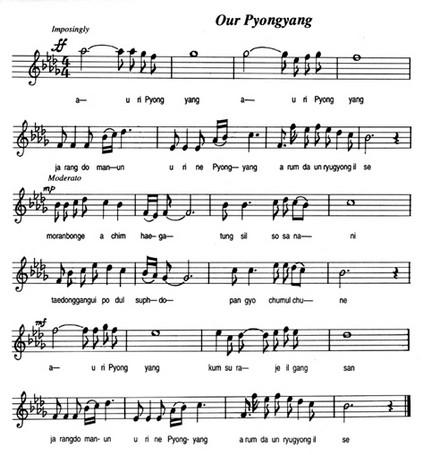
Scene 1. Willows in Spring
Scene 1 shows through the lyrical rhythmic movements the life of girls full of romance and joy of youth at the Taedong riverside on a balmy spring day.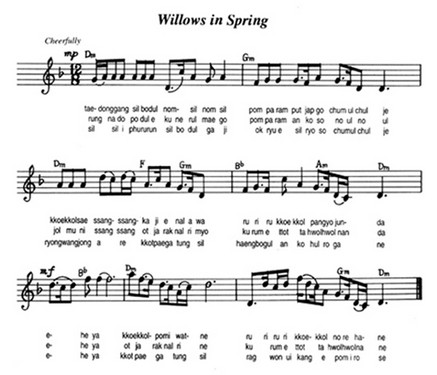
Scene 2. Training Ground of Martial Arts in Mt. Ryongak
Scene 2 shows the life of the people in the Walled City of Pyongyang training martial arts in Mt. Ryongak to defend their dear native land from foreign invaders.
Scene 3. Mother’s Mind
Scene 3 depicts a patriotic mind of mother who makes her dear son a man of Herculean strength of the country.
1. Turning a spinning wheel at dawn
Mother thinks of her son far away
And pictures in her mind the image of her son
Who went to a training ground of martial arts
with a firm pledge.
I come to attend you, lonely mother
Longing for you waking or sleeping.
2. Don’t go worrying about this mother and go quick,
My mind will always be with you.
Bearing deep in mind what you said,
I’ll never return home before becoming a man of
Herculean strength of the country.
Scene 4. The Autumn in a Mountain Fortress
Scene 4 shows through the optimistic dance movement the sincerity and patriotism of women in the Walled City of Pyongyang through the diligent working life of girls practising an archery while reaping a harvest in their native land where grains ripen.
Scene 5. Hunters of Raknang
Scene 5 represents through a hunting dance the wisdom and courage of young men of Pyongyang.
Scene 6. The Sound of Pounding Clothes in the Moonlit Night
Scene 6 shows through the cheerful and optimistic rhythmic movements the looks of women pounding clothes in the charming moonlit autumn night.
Scene 7. The Spring of Moran Hill
Scene 7 represents through janggo dance and tune the scenery of the most beautiful Moran Hill.
Scene 8. The Oath
Scene 8 shows through a sword dance the will of women to fight to the last should the enemy attack the Walled City of Pyongyang, their dear native land.
Scene 9. The Signal-fire on Jangsu Peak
Scene 9 depicts through the living rhythmic movements the ardent patriotism of young people who turn out in the fight to defend the country when the signal-fire of war is lit on the day of wedding.
Scene 10. Warriors in the Walled City of Pyongyang
Scene 10 depicts through an active and dignified dance the strong will and bravery of warriors in every fight against the invaders.
Scene 11. Joy of Triumph
Scene 11 represents through the merry tune of drums and powerful dance movement the joy of defeating foreign invaders and defending the Walled City of Pyongyang.
Finale
The finale shows through a dance and a song the wisdom and bravery of the people in the Walled City of Pyongyang who defended firmly their native land.

